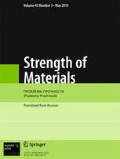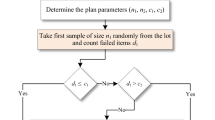This paper considers both likelihood and Bayesian estimations of a constant-stress partially accelerated life test model with type-I censored data from the linear failure rate distribution. The maximum likelihood estimates of the model parameters are obtained using Newton–Raphson technique. The posterior means and posterior variances are obtained under the squared error loss function using Lindley’s approximation procedure. The advantages of this approximation are exposed. Monte Carlo simulations are prepared under different sizes of samples and different parameter values for comparing and evaluating the proposed methods of estimation.


Similar content being viewed by others
References
Q. Fu and Y. Shi, “Constant-partially accelerated life tests for Marshall–Olkin exponential series system with dependent masked data,” Commun. Stat.-Simul. C., 46, No. 10, 7879–7893 (2017).
A. A. Ismail and A. A. Al-Babtain, “Planning failure-censored constant-stress partially accelerated life test,” J. Syst. Eng. Electron., 26, No. 3, 644–650 (2015).
Ali A. Ismail, “Estimating the generalized exponential distribution parameters and the acceleration factor under constant stress partially accelerated life testing with type-II censoring,” Strength Mater., 45, No. 6, 693–702 (2013).
Ali A. Ismail, “On designing constant-stress partially accelerated life tests under time-censoring,” Strength Mater., 46, No. 1, 132–139 (2014).
Ali A. Ismail, “Bayesian estimation under constant-stress partially accelerated life test for Pareto distribution with type-I censoring,” Strength Mater., 47, No. 4, 633–641 (2015).
Ali A. Ismail and A. Al Tamimi, “Optimum constant-stress partially accelerated life test plans using type-I censored data from the inverse Weibull distribution,” Strength Mater., 49, No. 6, 847–855 (2017).
Ali A. Ismail and A. Al Tamimi, “Optimal design of failure-censored constant-stress life test plans for the inverse Weibull distribution,” Strength Mater., 51, No. 1, 156–165 (2019).
Ali A. Ismail, “Planning step-stress life tests for the generalized Rayleigh distribution under progressive type-II censoring with binomial removals,” Strength Mater., 49, No. 2, 292–306 (2017).
Ali A. Ismail and K. Al-Habardi, “On designing time-censored step-stress life test for the Burr type-XII distribution,” Strength Mater., 49, No. 5, 699–709 (2017).
W. Nelson, Accelerated Testing: Statistical Models, Test Plans, and Data Analysis, John Wiley & Sons, New York (1990).
S. Broadbent, “Simple mortality rates,” J. R. Stat. Soc. C-Appl., 7, 86–95 (1958).
P. O. Carbone, L. E. Kellerhouse, and E. A. Gehan, “Plasmacytic myeloma: a study of the relationship of survival to various clinical manifestations and anomalous protein type in 112 patients,” Am. J. Med., 42, 937–948 (1967).
D. Kodlin, “A new response time distribution,” Biometrics, 2, 227–239 (1967).
D. V. Lindley, “Approximate Bayesian methods,” Trabajos de Estadistica, 31, 223–245 (1980).
J. Green, “Discussant on D. V. Lindley’s (1980) paper on approximate Bayesian methods,” Trabajos de Estadistica, 31, 241–243 (1980).
S. K. Sinha, Reliability and Life Testing, Wiley Eastern/Halstead, New York (1986). 180
Author information
Authors and Affiliations
Corresponding author
Additional information
Translated from Problemy Prochnosti, No. 1, pp. 192 – 202, January – February, 2020.
Appendix
Appendix
The derivation of posterior means and posterior variances: here, there are three parameters in the model. That is, m = 3. Let the subscripts 1, 2, and 3 refer to β, α, and θ, respectively. It is not easy to obtain the posterior moments analytically. Therefore, using Lindley expansion, the posterior mean (i.e., Bayesian estimator under squared-error loss function) and the posterior variance of β are given, respectively, in the form:
and
Similarly, for the shape parameter α, the posterior mean and the posterior variance are given by
Applying the same technique, the posterior mean and posterior variance of the scale parameter θ take the following form:
and
where
for i, j = 1, 2, 3, σij are the elements of the inverse of the asymptotic Fisher-information matrix of the ML estimators of β, θ, and α in the case of type-I censored data and i, j = 1, 2, 3, \( {L}_{ijk}^{(3)} \) is the third derivatives of the natural logarithm of the likelihood function in type-I censoring.
To compute the posterior means and the posterior variances of β, θ, and α derived before, both second and third derivatives of the natural logarithm of the likelihood function given in ((2) must be obtained.
The second derivatives can be given via the following equations:
Third derivatives are calculated as follows:
Rights and permissions
About this article
Cite this article
Ismail, A.A., Al-Harbi, M.M. Bayesian Estimation of Constant-Stress Life Test Model Using Type-I Censored Data from the Linear Failure Rate Distribution. Strength Mater 52, 171–180 (2020). https://doi.org/10.1007/s11223-020-00162-1
Received:
Published:
Issue Date:
DOI: https://doi.org/10.1007/s11223-020-00162-1




